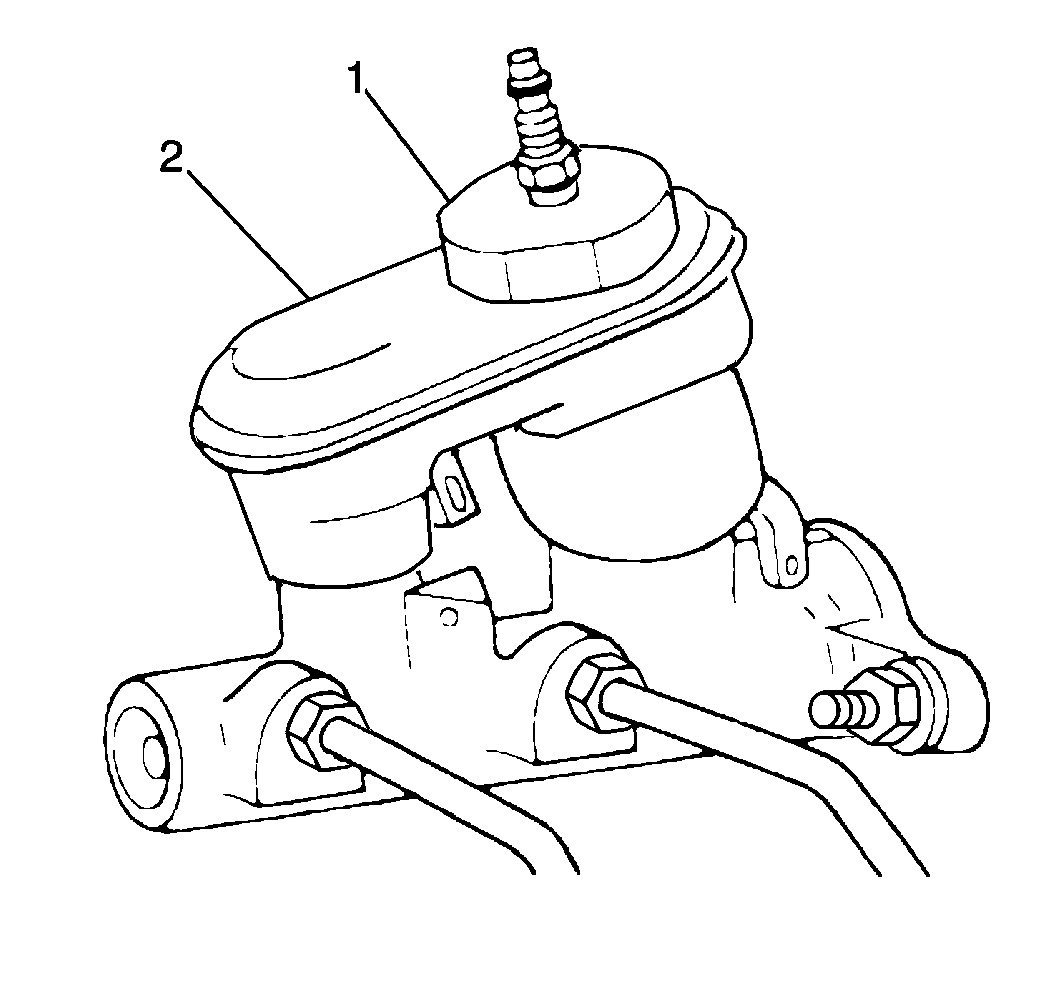Notice: Brake fluid is extremely damaging to paint. If fluid should accidentally
touch a painted surface, immediately wipe fluid from paint and clean the painted
surface.
Tools Required
The bleeding procedure is necessary to remove air whenever it is introduced
into the hydraulic brake system.
Bleed the hydraulic system at all four brakes if air has been introduced
by a low fluid condition or disconnecting the brake pipes at the master cylinder
or the Brake Pressure Modulator (BPM) valve. If a brake pipe is disconnected
at any wheel only that caliper need be bled. Pipes are disconnected at
any fitting located between the master cylinder and the brakes then the
brake system served by the disconnected pipe must be bled.
Manual Bleeding
Remove the booster vacuum reserve by applying the brakes several times
with the ignition OFF.

- Fill the master cylinder
reservoir with brake fluid and keep the reservoir at least one-half full of
fluid during the bleeding operation.
- The master cylinder should be bled before the calipers are bled.
If the master cylinder is known or suspected to have air in the bore. Bleed
as follows:
| 2.1. | Disconnect the forward brake pipe connection at the master cylinder. |
| 2.2. | Fill the master cylinder with brake fluid until it begins to flow
from the forward pipe connector port. |
| 2.3. | Connect the forward brake pipe to the master cylinder and tighten. |
| 2.4. | Slowly depress the brake pedal and hold. |
| 2.5. | Loosen the forward brake pipe connection at the master cylinder
to purge air from the cylinder. |
| 2.6. | Tighten the connection. |
Tighten
Tighten the brake pipe to 32 N·m (24 lb ft).
Notice: Use the correct fastener in the correct location. Replacement fasteners
must be the correct part number for that application. Fasteners requiring
replacement or fasteners requiring the use of thread locking compound or sealant
are identified in the service procedure. Do not use paints, lubricants, or
corrosion inhibitors on fasteners or fastener joint surfaces unless specified.
These coatings affect fastener torque and joint clamping force and may damage
the fastener. Use the correct tightening sequence and specifications when
installing fasteners in order to avoid damage to parts and systems.
| 2.7. | Slowly release the brake pedal. |
| 2.8. | Wait 15 seconds and repeat steps until all air is removed from
the bore. |
| 2.9. | Bleed the master cylinder at the rear (cowl end) connection after
all the air has been removed at the forward connection. Slowly depress the
brake pedal and hold. |
| 2.10. | Check for firm pedal feel and proper brake pedal travel. If the
wheel cylinders and calipers do not contain air bleeding may not be necessary. |
- Bleed the individual calipers after all air is removed from the
master cylinder.
| 3.2. | Attach a transparent tube over the valve and allow tube to hang
submerged in a transparent contained filled with brake fluid. |
| 3.3. | Slowly depress the brake pedal and hold. |
| 3.4. | Loosen the bleeder valve to purge the air from the cylinder. |
| 3.5. | Tighten the bleeder screw. |
Tighten
Tighten the brake bleeder valves to 13 N·m (10 lb ft).
| 3.6. | Slowly release the pedal. |
| 3.8. | Repeat the sequence until all air is removed from the caliper. |
Do not pump the brake pedal rapidly. Pumping pushes the master cylinder
secondary piston down the bore which causes difficulty bleeding.
- Repeat the bleeding sequence.
| 4.1. | Bleed the left front caliper. |
| 4.2. | Bleed the right front caliper. |
| 4.3. | Bleed the left rear caliper. |
| 4.4. | Bleed the right rear caliper. |
- Check the brake pedal for sponginess.
- Repeat the entire bleeding procedure if a low brake pedal or pedal
sponginess is encountered.
Pressure Bleeding
Tools Required
J 35589 Bleeder Adapter

- Remove the master cylinder
reservoir cap and replace with J 35589
.
- Charge the bleeder to 140-172 kPa (20-25 psi).
- Connect the hose to the J 35589
.
- Open the valve on the brake bleeder tank.
- Raise the vehicle and the suitable support . Refer to
Lifting and Jacking the Vehicle
in General Information.
- Place a proper size wrench over the bleed screw.
- Attach a clear tube over the screw and allow the tube to hang
submerged in a clear container partially filled with brake fluid.
- Open the bleed screw at least 3/4 turn and allow flow to continue
until no air is seen in the fluid.
- Close the bleed screw.
Tighten
Tighten bleed screws to 13 N·m (10 lb ft).
Notice: Use the correct fastener in the correct location. Replacement fasteners
must be the correct part number for that application. Fasteners requiring
replacement or fasteners requiring the use of thread locking compound or sealant
are identified in the service procedure. Do not use paints, lubricants, or
corrosion inhibitors on fasteners or fastener joint surfaces unless specified.
These coatings affect fastener torque and joint clamping force and may damage
the fastener. Use the correct tightening sequence and specifications when
installing fasteners in order to avoid damage to parts and systems.
- Repeat bleeding sequence in order.
| 10.1. | Bleed the left front caliper. |
| 10.2. | Bleed the right front caliper. |
| 10.3. | Bleed the left rear caliper. |
| 10.4. | Bleed the right rear caliper. |
- Lower the vehicle. Refer to
Lifting and Jacking the Vehicle
in General Information.
- Check the brake pedal for sponginess. Repeat the entire bleeding
procedure if a low brake pedal or sponginess is found.
- Remove the brake bleeding equipment from the master cylinder.


